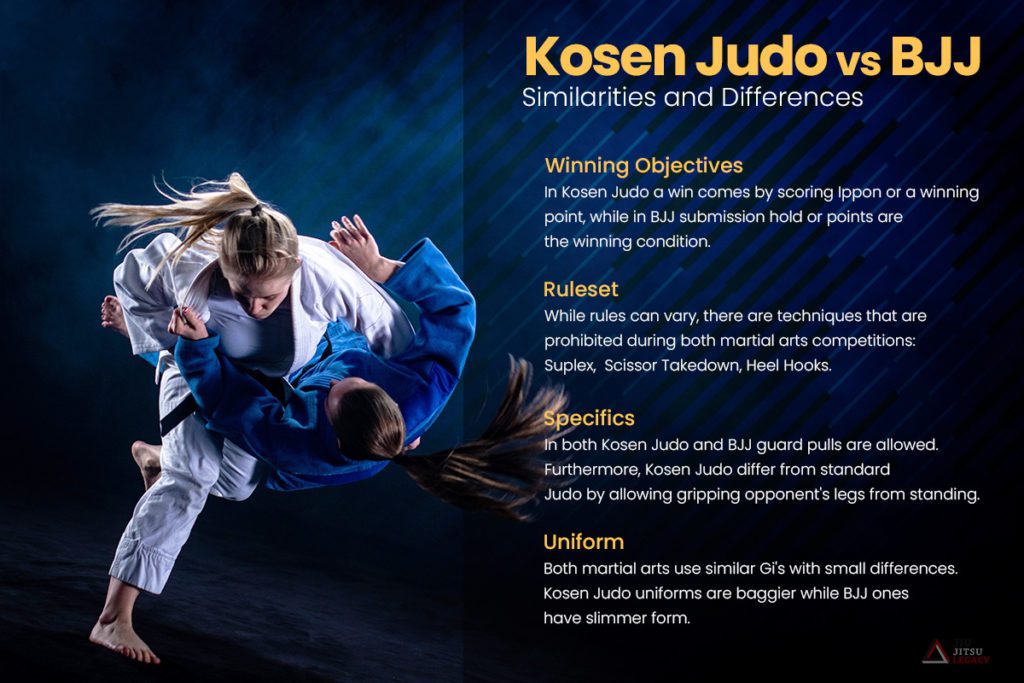Kosen Judo is perhaps the closest relative to Brazilian Jiu Jitsu in the martial arts family. Many BJJ practitioners will be surprised to learn that the triangle choke was not a part of the style of Judo which arrived in Brazil when Mitsuyo Maeda crossed the ocean! Instead, this technique arose later out of the Kosen Judo style!
This article has everything you need to know about Kosen Judo, its history, rules, and how it compares to BJJ.
What is Kosen Judo?

Simply put: Kosen Judo is the branch of Judo that focuses on ground grappling, which in Judo are referred to as Ne-waza. Traditional Judo matches are won with an Ippon which can be eatrned by a successful throw, pin, or submission. In Kosen Judo a practitioner can secure an Ippon with a pin, choke, or a joint lock.
The biggest difference between Kosen Judo and traditional Judo is Hikikomi, or guard pulling. Practitioners in Kosen Judo are allowed to pull guard in competition rather than try and throw their opponent. This allows them to attempt sweeps from the bottom and set up submissions that aren’t available in traditional Judo.
Other differences between Kosen Judo and Judo include the ability to grab your opponent’s legs from standing and to use two-handed grip breaks.
History of Kosen Judo
Kosen Judo is an abbreviation of “kōtō senmon gakkō.” This expression referred to universities in Japan in the 19th century, where Kosen Judo was first taught. Jigoro Kano decided to alter the rule set to allow more newaza, or ground techniques. He did this, so it would be easier to adapt Judo moves for use in a sport context.
The first Kosen Judo matches were held in 1898, and the first Kosen Judo competition was held between schools in 1914. The competition was organized by Kano himself.
However, Judo masters Tsunetane Oda and Yaichihiyoe Kanemitsu are credited with developing many of the Newaza for Kosen Judo, including the famous Sankaku Jime or triangle choke. There is some debate about the exact origins of the triangle choke, but most sources say Yaichihiyoe Kanemitsu because it was his student to first apply it in a competition in 1921.
What’s important to realize then, is that this means the triangle wasn’t invented until after Count Mitsuyo Maeda made his famous journey to Brazil in 1910!
Another other famous Kosen Judoka you might already be familiar with is Masahiko Kimura. Kimura, who is also considered by some to be the best Judoka of all time, famously defeated Helio Gracie in Brazil with a double shoulder lock, the technique we now know simply as the Kimura shoulder lock.
Ultimately, Jigoro Kano grew dissatisfied with the rules of Kosen Judo, and the Kodokan changed the rules to limit the use of newaza and hikkomi in 1925. Despite the change, Kosen Judo continued being practiced – outside the jurisdiction of the Kodokan – and has remained basically unchanged to this day.
Kosen Judo Today
Today Kosen Judo is seen as its own independent branch of Judo. When people use the term Kosen Judo they generally mean the ruleset of Judo which allows ground work.
Two famous Judo competitions using these rule sets are the Nanatei and the Shichitei. These Judo competitions are held in Japan with the seven imperial universities participating.
Kosen Judo vs BJJ – Similarities and Differences

There are not actually many differences between the Kosen Judo and BJJ. However, if we are going to get technical, the differences come mostly from how competitions are won. Judo matches are generally settled faster than BJJ competitions, so don’t have as rigid a point system as BJJ.
Some Kosen Judo competitions have competitors compete as a team. Instead of awarding individual competitors medals, the team with the most Ippons is given the victory.
Another thing BJJ players watching Kosen Judo matches might notice is that Kosen Judo players pull guard and set up submissions somewhat differently. Kosen Judo players are more likely to throw flying armbars, or aggressively pull on the collar with the intent of pulling their opponent off their feet.
Winning Objectives
In order to win a Kosen Judo match, a practitioner must score Ippon or a winning point. This can be done by a 20-30* second pin, submission hold, or by accumulating two half-points called waza-ari. The submissions in Kosen Judo are more restrictive than in BJJ with only chokes and armbars being permitted.
Waza-ari, or half points, are scored by pinning your opponent for 10-29* seconds, or by throwing your competitor. This is a notable departure from traditional Judo, where a throw scores Ippon. To win by throwing your opponent in Kosen Judo you must throw your opponent twice, or throw them and then pin them.
*Note: The exact time required for a pin to count varies by ruling body.
In Brazilian Jiu Jitsu a win comes by way of submission hold or points. BJJ players score points by getting a sweep, takedown, guard pass, or securing a scoring position for 3 seconds. The point scoring positions in BJJ are knee on belly, mount, and back control.
Rules
Both BJJ and Kosen Judo are pretty lenient in their rule sets compared to other martial arts. They are both considered rough and highly competitive. However, they both have moves that are illegal and some shared techniques that are banned in both Kosen Judo and in BJJ. Some examples of shared banned techniques are:
- Suplex – Any throw or takedown where someone is brought down on their head is banned in BJJ and in Judo. These moves can be unnecessarily devastating, and often the position that they are thrown from have other safer options available.
- The Scissor Takedown – While scissor sweeps are legal in both Judo and BJJ, the standing scissor takedown is a very different move that puts a lot of stress on people’s knees and often results in injury.
- Heel Hooks – There was a time in Kosen Judo history where leg attacks were legal. However, these techniques are currently illegal in most Kosen Judo rulesets. BJJ allows ankle locks, but knee bars and twisting foot locks are illegal until advanced ranks, and heel hooks aren’t permitted in the gi.
Newaza and Hikkomi
Pulling guard in Kosen Judo is slightly different from pulling guard in BJJ. Judo players have a very aggressive way they pull guard because they are more likely to try and turn it into a sweep. When successfully performed, a guard pull which results in a sweep can score waza-ari, getting competitors halfway to victory. In BJJ a guard pull into a sweep only scores 2 points – valuable but not as vital.
Kosen Judo rules mirror common BJJ rules which require that a competitor must have grips established on their opponent before they pull guard! Simply sitting down is prohibited in both sports.
Uniform
Kosen Judo and BJJ have very similar gis – although there are small differences. Judo gi’s are required to be baggier, giving them a more squared shape. BJJ gis often have tapered sleeves and are more form fitting. This allows Judo throws to be more explosive and competitors have more ways to latch onto their opponents and get their hips in close.
BJJ also has a no-gi grappling component that focuses on grappling without the gi, while Kosen Judo does not have a no-gi equivalent.
FAQs

What does Kosen Judo mean?
Kosen Judo is an abbreviation of “kōtō senmon gakkō.” This literally translates to “Places of Higher Learning.” Kosen Judo was originally taught in universities and today the seven imperial colleges in Japan hold Kosen Judo competitions.
How do you win in Kosen Judo?
A practitioner can win a Kosen Judo match by scoring Ippon. Ippon comes by way of a pin, a submission, or scoring two waza-ari. A shorter pin or a successful throw scores waza-ari.
When was Kosen Judo founded?
The first Kosen Judo matches were held in 1898, and the first Kosen Judo tournament was held in 1914.
Conclusion
One of the biggest criticisms of BJJ is that it does not emphasize takedowns enough. To be a well-rounded martial artist, people who study “the way” must draw wisdom and techniques from many places. It would benefit all Jiu Jitsu practitioners to add some Judo to their standing game, and similarly it would benefit Judokas who want to compete in the Kosen ruleset to train BJJ.
At the end of the day, the two sports are more similar than different, and Kosen Judo is probably the closest relative to BJJ that exists today!

Jack is a D who holds a bachelors degree in English Literature. He enjoys traveling, reading, and the Bow and Arrow choke. One day he hopes to teach English overseas and become a published author.
